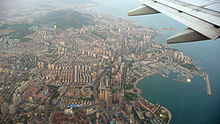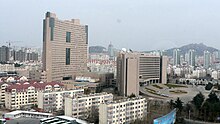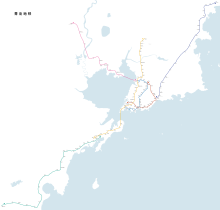Qingdao
| Qingdao Shi 青岛 市 Qingdao |
|
|---|---|
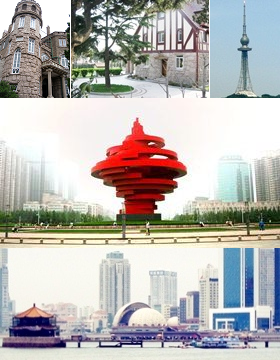 Cityscapes |
|
| Coordinates | 36 ° 5 ′ N , 120 ° 20 ′ E |
 Location of Qingdao in the People's Republic of China |
|
| Basic data | |
| Country | People's Republic of China |
| region | East china |
| province | Shandong |
| ISO 3166-2 | CN-SD |
| status | Sub-provincial town |
| structure | 7 city districts, 3 independent cities |
| surface | 1102 km² |
| Metropolitan area | 10,654 km² |
| Residents | 3,990,942 (2010) |
| Metropolitan area | 9,204,000 (2016) |
| density | 3,621.5 Ew. / km² |
| Metropolitan area | 863.9 Ew. / km² |
| Post Code | 266000 |
| Telephone code | +86 (0) 532 |
| Time zone | UTC + 8 |
| Website | english.qingdao.gov.cn (en) |
| politics | |
| mayor | Xia Geng ( 夏耕 ) |
Qingdao ( Chinese 青島市 / 青岛市 , pinyin , W.-G. Tsingtao Shih - "Green Island" out of date: ( bar ): Tsingtao ski ) is a port city in the province of Shandong outdated (: (rod ): Shantung ) in the east of the People's Republic of China . The abbreviation of the city 青 , qīng means "green", "blue-green", "turquoise", but also "lush / juicy" with an allusion to the vegetation.
From 1898 to 1919 the city belonged to the German Empire as a colony ( Kiautschou ) .
The coastal metropolis is known worldwide for its beer called Tsingtao , which has its origins in the German colonial era. Off the coast of Qingdao in 2008 the sailing competitions were Olympic Games of Beijing held.
| License plate : | 鲁 B & 鲁 U |
| Party leader of the CCP : | Li Qun ( 李群 ) |
| Registered population : | 7,630,000 (2010) |
| Economic data (2008): | |
| GDP total : | ¥ 443.6 billion |
| GDP per capita : | ¥ 52,687 |
Administrative structure
Qingdao reached its present size through the incorporation of the former Jimo, Jiaozhou and Jiaonan Counties in 1977 and Laixi and Pingdu in 1984. At the county level, Qingdao now consists of seven boroughs and three urban districts. These are:
| District level | Admin. Code |
Area (km²) |
Population (2010) |
Population density (inh / km²) |
|---|---|---|---|---|
| Shinan District ( 市南區 / 市南区 , Shìnán Qū - "South City") | 370202 | 30.01 | 544,800 | 18,153.95 |
| District Shibei ( 市北區 / 市北区 , Shibei Qū - "Northern Town") | 370203 | 63.18 | 1,020,700 | 16,155.43 |
| District Huangdao ( 黃島區 / 黄岛区 , Huángdǎo Qū ) | 370211 | 2220.1 | 1,392,600 | 627.27 |
| Laoshan District ( 嶗山 區 / 崂山 区 , Láoshān Qū ) | 370212 | 389.34 | 379,500 | 974.73 |
| District Licang ( 李滄區 / 李沧区 , Lǐcāng Qū ) | 370213 | 95.52 | 512,400 | 5,364.32 |
| Chengyang District ( 城陽區 / 城阳区 , Chéngyáng Qū ) | 370214 | 553.2 | 737.200 | 1,332.61 |
| Jimo District ( 即墨 区 , Jímò Qū ) | 370282 | 1727 | 1,177,200 | 681.64 |
| Jiaozhou City ( 膠 州市 / 胶 州市 , Jiāozhōu Shì ) | 370281 | 1210 | 843.100 | 696.78 |
| City of Pingdu ( 平度 市 , Píngdù Shì ) | 370283 | 3166 | 1,357,400 | 428.74 |
| City of Laixi ( 萊西 市 / 莱西 市 , Láixī Shì ) | 370285 | 1522 | 750,200 | 492.9 |
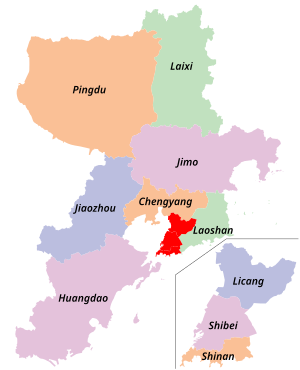
|
||||
etymology
According to the first known German-language records, the place was known as the "village of Chingtau-kau". In the following, the term "Tsintau" was initially used. On October 12, 1899, the German name “Tsingtau” was established.
Population development of the agglomeration
In 2017, almost 5.3 million people lived in the actual urban settlement area of the city. The rest of the population lives in the rural area. Due to advancing urbanization, 7 million inhabitants are expected in the agglomeration by 2035.
| year | population |
|---|---|
| 1950 | 751,000 |
| 1960 | 902,000 |
| 1970 | 906,000 |
| 1980 | 1,095,000 |
| 1990 | 2,165,000 |
| 2000 | 3,363,000 |
| 2010 | 4,512,000 |
| 2017 | 5,265,000 |
history
Qingdao had been a German colonial trade and navy base since the late 19th century. Efforts to have a base in East Asia can be traced back in Prussia to the year 1859, when a squadron of the Prussian Navy , the Prussian East Asia Expedition, left for East Asia that year .
Since the opening of China in the Opium Wars , trade and naval circles have been interested in providing German trade with China with the necessary military support, without which German merchants would have found it difficult to gain a foothold. Other states, including Great Britain , Russia and France , also established trading bases in China between 1842 and 1899.
In 1896 the imperial government decided to actively pursue the acquisition of a base. The attack on German missionaries, known as the Juye incident , in which two of them were killed, provided the opportunity to dispatch a cruiser squadron of the Imperial Navy under Rear Admiral Otto von Diederichs and to give China an ultimatum to give China a lease area. Given the superior military strength, China gave in. A lease for 99 years was signed on March 6, 1898. ( see: Gunboat Policy )
When it was occupied by German troops on November 14, 1897, Qingdao was a fishing village made of mud huts with a temple built around 1796 for the sky goddess and a 'yamen', the administrative seat in which a Chinese officer sat as head of administration, who was also subordinate to a small military unit .
From 1897 to 1914, Qingdao was under German rule as the capital of the “ German Kiautschou Protected Area ” . Many buildings from this period have been preserved, for example a brewery , a train station, a Protestant church and the governor's residence. The existing buildings and the lives of the residents were documented photographically for the first time in 1903-1906 by Friedrich Behme . West Shandong was one of the scenes of the Boxer Rebellion of 1900, which tried to drive the colonial rulers out of China. In 1913 the city's population consisted of 53,312 Chinese, 2,069 Europeans and Americans, 2,400 soldiers from the garrison , 205 Japanese and 25 other Asians.
After the beginning of the First World War in August 1914, with the siege of Tsingtau by the Japanese, the German troops in the city were forced to surrender after the last ammunition had been fired on November 7, 1914 and Tsingtau was occupied by the Japanese. The East Asia Squadron was in the South Seas at the beginning of the war and did not return to Tsingtau.
The German defenders were taken prisoner of war in Japan . They lived there in several camps and some were not released from captivity until 1920. The most famous camps were called Matsuyama and Bandō .
After the Japanese conquest of Tsingtau, Japanese merchants and tradesmen poured into the city. A Japanese quarter was created in which 17,597 Japanese were already living in 1920, who, like the Germans, had the ambition to build a " model colony ".
According to the provisions of the Versailles Treaty , the colony initially remained in Japanese hands. It was not returned to China until December 10, 1922. In the period that followed, the civil war-like conditions of the warlord era led to economic stagnation.
Under the Chinese national government and after the Second World War , the United States used Qingdao as a naval base at times . This ended in 1949 after the city was captured by the Chinese communists.
In 1986, a submarine base of the Navy of the People's Liberation Army was located near the port .
Monument Diederichsstein on Signalberg in Tsingtau
The city today
Qingdao has now become a city of millions. Many old colonial buildings gave way to the building boom that has continued to this day. Many of them were demolished until the 1990s. However, the most important buildings from that time have been preserved and protected by the city. Today Qingdao is proud of the architectural legacy from the German colonial era. Numerous hills in the urban area were leveled to create new building areas. The appreciation for the German architectural style goes so far that in several new building areas, in contrast to the usual high-rise construction, mainly medium-height, “German”-looking houses have been fitted into the green landscape.
The main buildings of the old town
economy
According to a study from 2014, Qingdao has a gross domestic product of 208.7 billion US dollars in purchasing power parity . In the ranking of the economically strongest metropolitan regions worldwide, the city took 52nd place. The GDP per capita is $ 23,281 (PPP). The city employed 2.7 million people. GDP per capita grew rapidly at 10% annually in the period from 2009 to 2014.
Economically, Qingdao developed very quickly after the opening of China in 1978.
Qingdao is known for the production of fish products, seafood , textiles ( Jean Pierre , Hong Ling etc.), household electronics ( Haier , Hisense , Aocma etc.) and tires ( Goodyear , Shuangxin etc.). The Korean Sejung Musical Instruments Co. Ltd. Established a large-scale production of musical instruments in 2001, which not only produces grand pianos and pianos, but also over 500,000 acoustic and electric guitars annually. The former German brewery is now a global company and now has breweries all over China, parts of Asia and North America. Their beer is sold worldwide under the name Tsingtao . In addition, the Qingdao Beer Festival , unique in China, has been held every year since 1991. It is modeled on the Munich Oktoberfest and attracts numerous tourists and German breweries.
In 2017 , Airbus and a Chinese partner are building a helicopter factory in Jimo , near Qingdao .
The German-Chinese Ecopark is also located in Qingdao .
In a ranking of the most important financial centers worldwide, Qingdao took 33rd place (as of 2018).
traffic
shipping
As a deep-sea port , Qingdao is important for the oil processing industry and freight traffic for the entire Shandong peninsula. The city's port is the third largest port in China and the eighth largest in the world. It includes the old port area, the Huangdao oil port, the new Qianwan port area and the Dongjiakou port area. The port of Qingdao is considered the world's largest port for iron ore imports, China's most important facility for receiving oil and the country's second most important port for foreign trade. According to the port administration, the total throughput of goods in 2011 was around 370 million tons. In 2012, container throughput amounted to around 14.5 million TEU , a good 11 percent more than in the previous year. The port will be expanded by 2020 for 4.7 billion euros. After the expansion, the port will replace the previous leader Shanghai and become the largest port in the world.
railroad
The Schantung Railway to Jinan was opened as early as 1904 . This was followed about 100 years later by two double-track , electrified high-speed lines in the same relation, including the high-speed line from Qingdao to Taiyuan . On December 26, 2018, the Qingdao – Jinan railway line (3) was opened as the third high-speed line in this relation and on the same day another new line from Qingdao to Yancheng was opened .
Road traffic
On December 27, 2010, the Jiaozhou Bay Bridge , which connects Qingdao with Huangdao and Qingdao-Liuting Airport , was completed. With a total length of 42 kilometers, it is the world's longest car bridge over water. The bridge was opened to traffic on June 30, 2011. The Jiaozhou Bay Tunnel , which also connects Qingdao with Xuejia Island in the Huangdao district and is 7.8 kilometers long, 3.95 kilometers of which is underwater, had already been built .
tram
The first section of the Qingdao tram opened on March 5, 2016. The 8.8 km long route has 12 stops . Only a short section of 400 m length runs along the road. A novelty in tram history is the fact that the vehicles were equipped with fuel cells. This made it possible to dispense with the overhead line on sections of the route.
Subway
A subway system is under construction. The Qingdao Metro was originally supposed to start operating in the second half of 2014, but after delays in construction, a first section of Line 3, 12 kilometers in length, was not released until December 2015. Another 12.8 km long section of this line with 12 stations was opened in December 2016.
The first section of Line 2 has been in operation since December 10, 2017. It is a 20.4 km long route that connects Zhiquan Lu with Licun Gongyuan and has a total of 18 stops. In the final stage, this line will be 61.3 km long and will have 41 stations.
In 2018, a first section of line 11 with a length of 54 km and line 13 with a length of 67 km went into operation.
A total of 16 lines and two feeder lines are planned. The entire route network is to have a length of 836 km and is to be completed around 2050.
Airport
The Qingdao Liuting International Airport is used primarily for national calls. It is about 20 km from the city center. The link to Germany has been underlined since 2012 with a direct Lufthansa connection between Frankfurt and Qingdao.
Since the airport has reached the limits of its capabilities, it is to be replaced by a new airport, Qingdao Jiaodong International Airport , around 2020 .
science
Qingdao is home to several universities, including the renowned Chinese Ocean University , a national competence center for marine technology and fisheries. The University of Science and Technology Qingdao and the University of Paderborn maintain the CDTF (Chinese-German Technical Faculty). Other universities include Qingdao University and Qingdao Technical University .
tourism
Qingdao is one of the few major seaside resorts in China. The Germans gave the city the nickname Naples on the Yellow Sea . Near the city is the Lao Shan excursion site with the Taoist temple Taiqing Gong . From the German colonial era, the governor's villa, the Protestant church, the Catholic cathedral (completed in 1934), the Zhan Qiao pier , parts of the German bunker system that can be visited and some other colonial buildings are still preserved. However, the unique panorama of the city was partially destroyed by high-rise buildings.
Fushan Bay, just six kilometers from the center of the city, with the Qingdao International Sailing Center, was the venue for the sailing competitions of the 2008 Summer Olympics .
In an annual selection in 2009, Qingdao was voted the most liveable city in mainland China by a Hong Kong- based institute . In addition, the Chinese Institute for Competitive Strength determined in 2012 that Qingdao is the happiest city in China.
Twin cities
|
|
Personalities
- Richard Wunsch (1869–1911), German doctor, from 1908 head of the Faber Hospital in Qingdao
- Edmund Dipper (1871–1933), German general practitioner and gynecologist, from 1901 to 1908 head of the Faber Hospital in Qingdao
- Richard Wilhelm (1873–1930), German sinologist and theologian , worked between 1900 and 1920 as a pastor and teacher in the city
- Gunther Plüschow (1886-1931), was in World War I as pilots of Qingdao known
- Hellmut Wilhelm (1905–1990), German sinologist born in Tsingtau , son of Richard Wilhelm
- Toshirō Mifune (Japanese 三 船 敏 郎 Mifune Toshirō; 1920–1997), Japanese actor born in Qingdao
- Hachidai Nakamura (1931–1992), Japanese jazz pianist and songwriter
- Ma Jian (* 1953), Qingdao-born writer
- Li Cunxin (* 1961), ballet dancer
- Huang Xiaoming (* 1977), actor and singer
- Fan Bingbing (born 1981), actress
- Bu Xiangzhi (* 1985), chess grandmaster , was the youngest player in chess history to achieve the title of grandmaster in 1999
- Zhang Jike (* 1988), table tennis world champion
- Huang Zitao (* 1993), singer, rapper, actor and until 2015 member of the boy group Exo
Climate table
| Qingdao | ||||||||||||||||||||||||||||||||||||||||||||||||
|---|---|---|---|---|---|---|---|---|---|---|---|---|---|---|---|---|---|---|---|---|---|---|---|---|---|---|---|---|---|---|---|---|---|---|---|---|---|---|---|---|---|---|---|---|---|---|---|---|
| Climate diagram | ||||||||||||||||||||||||||||||||||||||||||||||||
| ||||||||||||||||||||||||||||||||||||||||||||||||
|
Average monthly temperatures and rainfall for Qingdao
Source: wetterkontor.de
|
|||||||||||||||||||||||||||||||||||||||||||||||||||||||||||||||||||||||||||||||||||||||||||||||||||||||||||||||||||||||||||||||||||||||||||||||||||||||||||||||||||||||||||||||||||||||||||||||||||
See also
literature
- Annette S. Biener: The German leasehold area Tsingtau in the province of Shantung, 1897-1914. Institutional change through colonization (= studies and sources on the history of Shantungs and Tsingtau. Vol. 6). Matzat, Bonn 2001, ISBN 3-924603-05-7 .
- Cord Eberspächer: The German Yangtze Patrol. German gunboat policy in China in the age of imperialism 1900–1914 (= Small series of publications on military and naval history. Vol. 8). Winkler, Bochum 2004, ISBN 3-89911-006-4 (also: Hamburg, University, dissertation, 2002).
- Sabina Groeneveld: Second home Tsingtau: Qingdao (1897-1914) in the mirror of German personal reports. (= Transpositions: Australian studies on German literature, philosophy and culture. Vol. 11). Röhrig Universitätsverlag, St. Ingbert 2019, ISBN 3-86110-739-2 (Also: Sydney, University, Dissertation, 2015).
- Heiko Herold: German colonial and economic policy in China 1840 to 1914. With special consideration of the marine colony Kiautschou. 2nd, improved and enlarged edition. Ozeanverlag Herold, Cologne 2006, ISBN 3-939424-00-5 .
- Hans-Martin Hinz , Christoph Lind (Ed.): Tsingtau. A chapter of German colonial history 1897–1914. German Historical Museum u. a., Berlin 1998, ISBN 3-86102-100-5 , online .
- Chun-Shik Kim: German cultural imperialism in China. German colonial schools in Kiautschou (China) 1898–1914 (= Mission History Archive. Vol. 8). Franz Steiner, Stuttgart 2004, ISBN 3-515-08570-X (At the same time: Hamburg, University, dissertation, 2004: German colonial schools in Kiautschou (China) 1898–1914. ).
- Christian Lautenbach (Ed.): Between the eras. Upheavals in the Far East. Eyewitness accounts from the Chinese revolution of 1911, the battle for Tsingtau and the imprisonment in Japan. Preface by Wan-Hsuan Yao-Weyrauch. Longtai-Verlag, Heuchelheim 2007, ISBN 978-3-938946-09-1 .
- Günter Leicht (Ed.): The Tsingtau diary of Rodheimer Rudolf Schlierbach. Preface by Wan-Hsuan Yao-Weyrauch. Longtai-Verlag, Heuchelheim 2006, ISBN 3-938946-05-9 .
- Klaus Mühlhahn: Rule and resistance in the "model colony" Kiautschou. Interactions between China and Germany 1897–1914 (= Studies on International History. Vol. 8). Oldenbourg, Munich 2000, ISBN 3-486-56465-X (also: Berlin, Free University, dissertation, 1998).
- Hans Georg Prager : Tsingtau / Qingdao. German heritage in China. With a foreword by the head of the Chinese History Museum in Tsingtau. Ares, Graz 2012, ISBN 978-3-902475-93-0 .
- Ingo Sommer : Tsingtau, a German naval city in China 1897-1914. In: H. Klüver (ed.): Foreign deployments of German warships in peace, small series of publications on military and naval history. Volume 7. Winkler-Verlag Bochum, Bochum 2003, ISBN 3-89911-007-2 , ISSN 1617-3074.
- Ingo Sommer: Tsingtau, North German garrison town in China 1897-1914 , in: The history calendar for the year 2000 , Brune-Mettcker Druck- und Verlagsgesellschaft Jever, Jever 2000.
- Bernhard Kußmagk: Tram boom in the Far East , in: Straßenbahn Magazin , issue 4/2017, p. 20
Trivia
- Sibylle Spindler: The doctor from Tsingtau , historical novel, construction publishing house, Berlin, ISBN 978-3-7466-3092-2
Individual evidence
- ↑ Local government Qingdao ( Memento of the original from August 4, 2010 in the Internet Archive ) Info: The archive link was automatically inserted and not yet checked. Please check the original and archive link according to the instructions and then remove this notice.
- ↑ Character "qing (青)", Chinese: on zdic.net , accessed on October 22, 2017
- ↑ Character "qing (青)", Chinese / German: on dict.leo.org , accessed on October 22, 2017
- ↑ HKTDC
- ^ Franzius, Georg: Kiautschou: Germany's acquisition in East Asia, 1898, map on page 185
- ^ Friedrich Wilhelm Mohr: Handbook for the Kiautschou Protected Area , page 22 (online)
- ↑ World Urbanization Prospects - Population Division - United Nations. Retrieved July 23, 2018 .
- ↑ Willibald von Stuermer: "The German Colonial Empire - overview of its design and its destiny", 1931, page 10
- ^ Reis im Bier , Spiegel Online one day, May 27, 2008
- ^ Alan Berube, Jesus Leal Trujillo, Tao Ran, and Joseph Parilla: Global Metro Monitor . In: Brookings . January 22, 2015 ( brookings.edu [accessed July 30, 2018]).
- ↑ Airbus builds helicopter factory in China orf.at, May 11, 2017, accessed May 11, 2017.
- ↑ The Global Financial Centers Index 23. (PDF) Archived from the original on March 27, 2018 ; accessed on July 13, 2018 .
- ↑ Dirk Ruppik: Qingdao on the way to the top of the world , in: Internationales Verkehrwesen . 65th vol., Issue 1, 2013, pp. 34–36.
- ↑ Port expansion: The world's largest port is being built in China , FAZ from October 1, 2012
- ↑ bac: China is putting numerous new lines into operation . In: Eisenbahn-Revue International 4/2019, p. 186f.
- ↑ Oliver Pickup: A bridge too far? China unveils world's longest sea bridge which is five miles FURTHER than the Dover-Calais crossing. In: Daily Mail Online. January 3, 2011, accessed November 26, 2015 .
- ↑ China opens longest sea bridge in the world , Spiegel from June 30, 2011 (queried on July 18, 2011).
- ↑ China completes second undersea tunnel , China Daily from April 28, 2010 ( accessed on July 18, 2011)
- ^ Qingdao opens fuel cell tram route . Railway Gazette March 7, 2016, accessed March 24, 2016
- ^ Qingdao metro opens . Railway Gazette of December 17, 2015, accessed March 11, 2016
- ↑ metro-report.com from December 19, 2016: Qingdao metro doubles in size (English), accessed on December 11, 2017
- ↑ metro-report.com of December 11, 2017: Qingdao metro Line 2 opens (English), accessed on December 11, 2017
- ↑ [1] xinhunaner from 2018, accessed on December 23, 2019.
- ↑ centreofaviation.com (English) accessed on December 14, 2017
- ^ CCTV: List of 10 most livable cities in China issued
- ↑ Ranking of the happiest cities in China 2012: Qingdao at the top. In: Radio China International. November 6, 2012, accessed November 26, 2015 .
- ↑ Qingdao is Mannheim's new twin city. Retrieved September 23, 2016 .
- ↑ according to the afterword on p. 493: Evaluation of old photos and the daily newspaper Tsingtauer Latest News (1904–1914)
- ↑ detailed review of a "historical novel" at tsingau.info
Movie
- Dietmar Schulz: Tsingtau - On the German trail in China . Germany 2008. (Documentation)
Web links
- Federal archive images on Tsingtau at Wikimedia Commons (790 entries, historical images)
- Gallery of the Federal Archives on the German Colony in Qingdao
- Winfried Schumacher: Kaiser Wilhelm Far East, Badische Zeitung , August 22, 2008
- Jürgen Ritter: "The German Hong Kong", Spiegel Online , May 19, 2008
- Official site of the city of Qingdao (English)
- An old travelogue
- Informative exhibition in Berlin 1998, organized by the city of Qingdao
- The defenders of Tsingtau and their captivity in Japan (1914 to 1920) by Hans-Joachim Schmidt
- The defense of Tsingtau in World War I.
- Biographies of Tsingtau Germans and texts / books by Prof. W. Matzat, Bonn
- Sino-German Technical Faculty Paderborn-Qingdao
- "Old German Buildings in Qingdao"
- "Cadastral maps on a scale of 1: 2000 from around 1914"
- Overviews and images of Kiautschou - Tsingtau at deutsche Schutzgebiete.de
- Tsingtauer Latest news on DDB
- Tsingtau address books 1901-1914 at tsingtau.org
- Plan of Tsingtau and the surrounding area with proof of address, published by Adolf Haupt in 1910, full text from Christian-Albrechts-Universität Kiel
- Almut Finck: November 7th, 1914 - German troops surrender in Tsingtau WDR ZeitZeichen from November 7th, 2014 (podcast)








